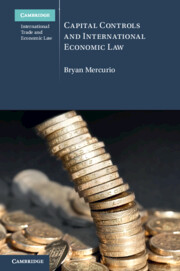Book contents
- Capital Controls and International Economic Law
- Cambridge International Trade and Economic Law
- Capital Controls and International Economic Law
- Copyright page
- Contents
- Foreword
- Preface
- Acknowledgements
- Abbreviations
- Part I Key Concepts: Capital Flows and Controls
- Part II The IMF, Capital Flows and Controls
- Part III Legal Frameworks, Rules and Conflicts
- 5 The Multilateral Trade Framework
- 6 Bilateral and Regional Trade Agreements
- 7 International Investment Agreements
- 8 Conclusions
- Bibliography
- Index
7 - International Investment Agreements
from Part III - Legal Frameworks, Rules and Conflicts
Published online by Cambridge University Press: 18 May 2023
- Capital Controls and International Economic Law
- Cambridge International Trade and Economic Law
- Capital Controls and International Economic Law
- Copyright page
- Contents
- Foreword
- Preface
- Acknowledgements
- Abbreviations
- Part I Key Concepts: Capital Flows and Controls
- Part II The IMF, Capital Flows and Controls
- Part III Legal Frameworks, Rules and Conflicts
- 5 The Multilateral Trade Framework
- 6 Bilateral and Regional Trade Agreements
- 7 International Investment Agreements
- 8 Conclusions
- Bibliography
- Index
Summary
Having clarified how capital movements are regulated at the multilateral level and explained how the multilateral framework translates to the bilateral or regional levels through FTAs, we now turn to the third level of regulation made available in an international law context – international investment agreements (IIAs). IIAs are critical to capital movements and capital flows in that they create a specific legal framework with substantive provisions aimed at protecting and promoting cross-border investors and investment. Like the previous chapter, this chapter refers extensively to the four representative comprehensive treaties – CPTPP, USMCA, RCEP and CETA. Where applicable, reference is made to other agreements, and in particular agreements negotiated by developing countries. The main conclusion of the chapter is that modern IIAs contain a wide range of safeguards and limitations which effectively allow host governments to put CFMs into place in circumstances of financial instability and financial duress. Moreover, the chapter also details how arbitral tribunals have narrowly interpreted state obligations and given substantial deference to host states when applying exceptions. That being said, treaties are drafted differently and the language, terms and choices made in drafting a treaty can significantly affect obligations and outcomes.
Keywords
- Type
- Chapter
- Information
- Capital Controls and International Economic Law , pp. 142 - 183Publisher: Cambridge University PressPrint publication year: 2023



